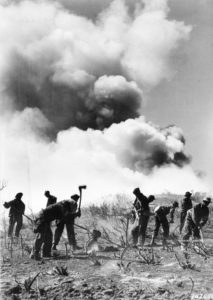In the wake of the most catastrophic wildfires in California’s history, Donald Trump accused state officials of shoddy forest management and recommended that the state’s dying forests should be raked. “Very important,” he said, to take care of the forest floor. Oddly enough, the New Deal’s enemies accused WPA workers of raking the forest as a synonym for boondoggling the taxpayers’ hard-earned cash.
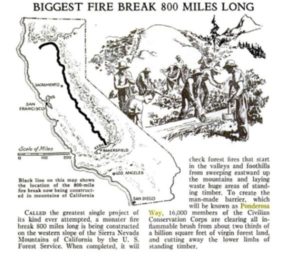
Popular Science Magazine, 1934
Black line on this map shows the location of the 800-mile fire break then being built to create the man-made barrier, which will be known as Ponderosa Way.
President Franklin Roosevelt knew a good deal more about forestry than his current successor. He described himself as a grower of trees, and historian Douglas Brinkley, who called him the Forester-in-Chief, ascribed the inception of the Ponderosa Way to him. FDR created the Civilian Conservation Corps (CCC) in 1933, and in 1934, CCC workers began to cut a north-south firebreak and access road—by some accounts up to 800 miles long—through the rugged foothills of California’s Sierra Nevada. The Ponderosa Way project employed 16,000 CCC men building bridges, laying culverts, and grading the road to create a barrier to keep wildfires in the scrubby lower elevations from reaching timber at mid-elevations. It was the CCC’s largest project in California.
FDR regretfully ended the CCC’s immense labor force in 1942 during the mobilization for World War II. The decline of the great California firebreak began almost immediately. In 1949, the federal government turned it over to the California Department of Forestry (CDF), which showed scant interest in maintaining it. At one point, the Ponderosa Way partially reverted back to federal jurisdiction, but no public agency much wanted the orphaned firebreak or remembered the purpose for which it had been so painstakingly built. It became discontinuous and, in many places, disappeared.
In 2007, the federal Bureau of Land Management (BLM) attempted to get some other agency to take responsibility for it. The CDF in Butte County told the BLM that what remained of the road might be useful for public access but it did not consider it vital for fire protection. Local resident Richard Faulkner, who at the time was living in the woods outside town, told a local newspaper, “For years now there hasn’t been any maintenance on this road of any kind. I want them to fix the road and maintain the bridge. I think it is very important from a fire standpoint.”
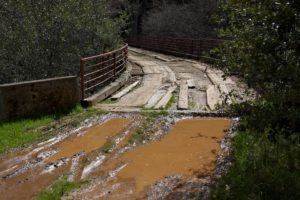
Ponderosa Way South over the North Fork of the Calaveras River
CCC bridge built in 1935. The deck was destroyed by the Butte Fire in 2015 and never repaired.
Photo Credit: Craig Philpott Courtesy Craig Philpott
When the Camp Fire, considered the worst wildfire in California in more than a century virtually erased the town of Paradise last month, few knew that the lengthy CCC firebreak transected the town. Like so many other public works bequeathed to us by the New Deal, it is a relic of a lost civilization that we neglect at our own peril. Whether the Ponderosa Way could have saved the town or offered an evacuation route may never be known.
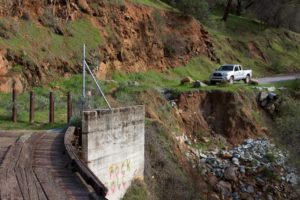
Ponderosa Way, North fork of the Mokelumne River, Amador and Calaveras Counties, California.
After the road deck was destroyed by fire, Ponderosa Way leading up to it was abandoned. It fell into disrepair and was deemed unsafe.
Photo Credit: Craig Philpott Courtesy Craig Philpott
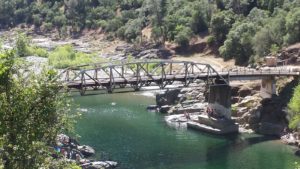
Ponderosa Way Bridge crossing the North Fork of the American River Placer County, California.
Pony truss bridge built in 1935. It is still open to traffic.
Photo Credit: Craig Philpott Courtesy Craig Philpott
